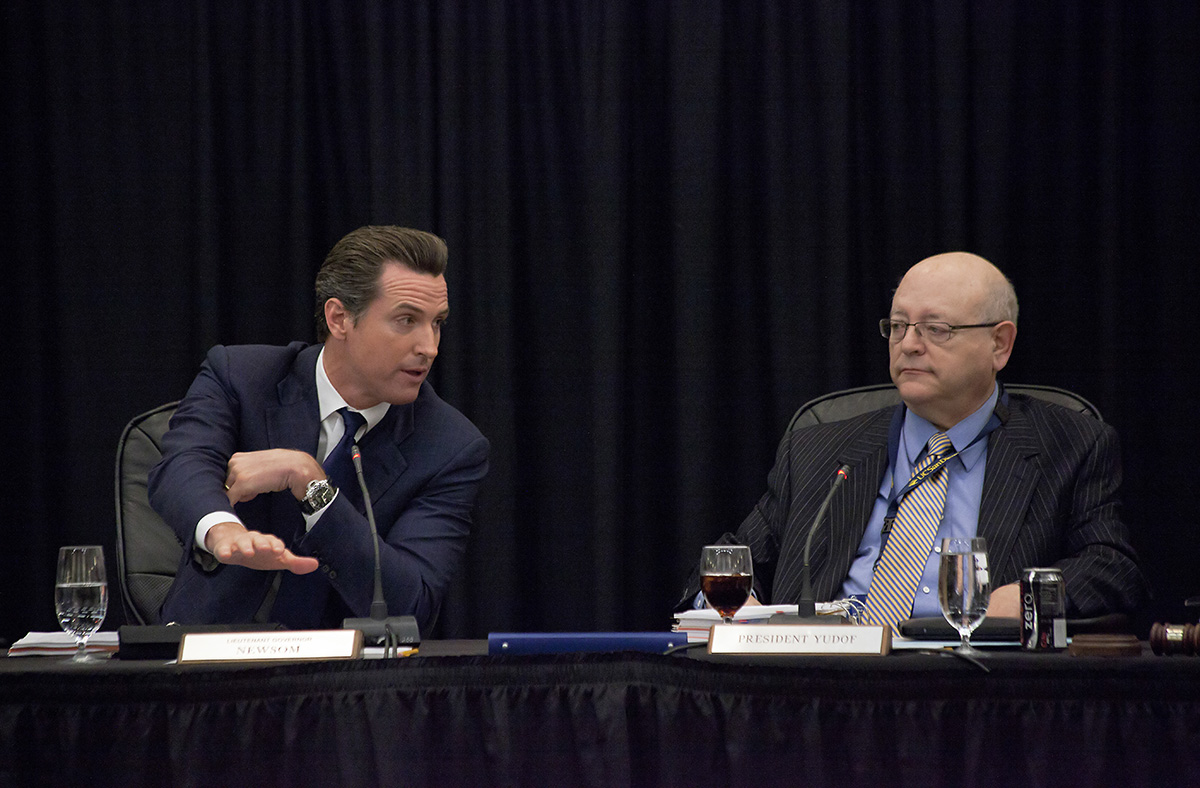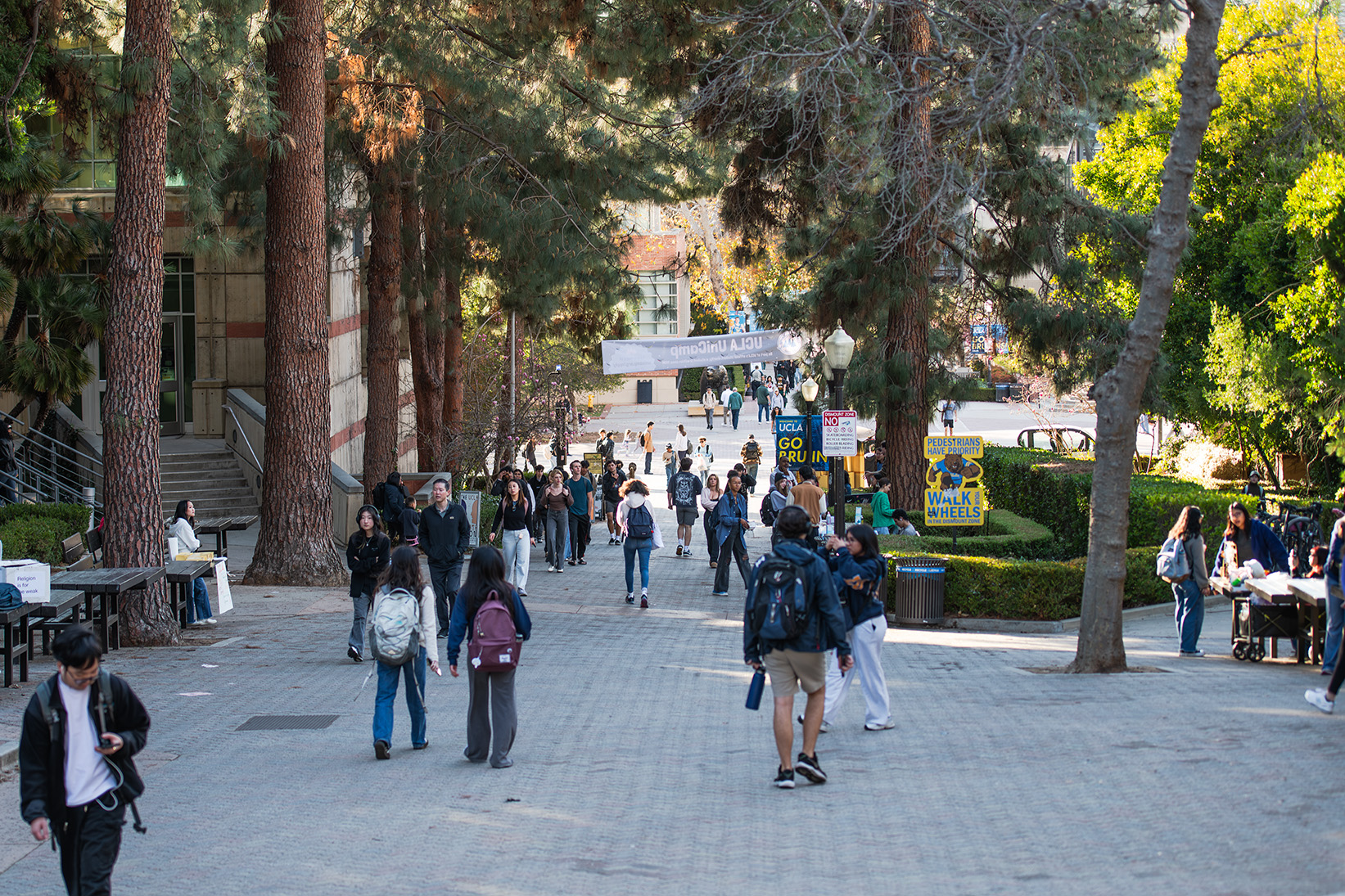A collage of student newspapers including the Daily Trojan, the University Daily Kansan, the Daily Collegian and the Indiana Daily Student. College newspapers across the country are facing budget cuts threatening the future of their print newspapers. (Photos courtesy of Henry Kofman/Daily Trojan, Marissa Meador/Indiana Daily Student, Chad Cushing/University Daily Kansan and Kate Hildebrand/The Collegian. Collage by Lindsey Murto/Design director)
By Natalia Mochernak
May 19, 2025 at 8:53 p.m.
Stefano Fendrich had only been editor in chief of the Daily Trojan for a few weeks when he received bad news.
The University of Southern California’s Student Life office told him the paper had a budget deficit of $80,000, print was being cut from daily to three days a week and his staff would no longer be paid, Fendrich said. The Trojan had been the last student newspaper printing daily on the West Coast.
The Trojan’s managing team had been pleading for greater transparency from USC Student Publications regarding its budget for months before it received notice of the cuts, he said. The team wanted to find out where its money came from and where it was going – but instead found out it was all gone, he said.
This loss of funding and lack of student control over finances at university newspapers is not unique to USC.
Within the last year, UC San Diego, Indiana University, the University of Kansas, the University of Nebraska Omaha, Pennsylvania State University and Rider University have all faced funding cuts to their student newspapers.
“We’ve never really been clued in how our money is being used, how much money we even have,” Fendrich said.
After being informed of potential budget cuts in summer 2024, The Trojan’s fall 2024 managing team published a letter asking USC student life for transparency regarding its budget and ability to fundraise independently from the school, Fendrich added.
“We are far from the only organization on campus facing budget cuts, but we struggle to rationalize why the University denies us the opportunity to address it,” the letter said. “We have ideas to fundraise; we are writing this because we want to help. We want to be active participants in the conversation and work toward solutions, but we cannot do this without financial transparency from the University.”
However, shortly after the letter was written, the team was informed that the school would no longer be funding The Trojan’s budget deficit, Fendrich said. He added that USC’s leadership made his managing team feel as though this budget crisis was the paper’s fault, even though none of the staffers had been told by any of the professional staff that it was an issue.
“In these meetings with them, it was very clear to me that they knew nothing about our paper,” Fendrich added. “And that makes it even more frustrating, because you don’t even know what you’re doing, and you’re telling us, ‘Oh, you have to do these things,’ and you don’t even understand the gravity of the situation.”
Marissa Meador, the co-editor in chief of the Indiana Daily Student at Indiana University, said she believes the cuts reflect a greater devaluation and mistrust of student journalism.
“Student news outlets aren’t always the most popular thing to defend or fund,” she added. “We’re constantly under fire from people in government or from groups on campus, and so it’s a hard thing to defend.”
In October 2024, the IU Media School cut the Daily Student’s weekly print to only select special issues to comprise seven issues per semester in hopes of addressing the paper’s $300,000 annual budget deficit. Meador said many of the Daily Student staff found out about the change through a press release.
“I think ultimately, no one really wants to solve this issue – at least no one in power at the Media School,” she said. “I think they’re just looking to look like they’re doing something.”
Meador added that the greatest implication of the print cut has been the difficulty of publishing relevant and newsworthy stories in print. She said though they have a consistent digital presence, the older adult community in Bloomington, Indiana, misses out on essential news when they can only read about an incident three weeks after it occurs.
Adalia Luo, the editor in chief of the UCSD Guardian, said a funding crisis has brought the paper from once daily to biweekly production. She added that the greater ramification of the funding cuts, however, has been no longer being able to pay staff members.
“It’s a real barrier to being able to do this work and being able to include a diversity of student perspectives in our reporting staff because we can’t afford to pay them for their labor,” she said. “It also means that there’s no room for expansion or growth within our team – our ability to offer professional programming is completely down because we’ve been managing a budget of nothing.”
She said the paper struggles to increase – or even maintain – the scope of its coverage and the quality of its work because it does not have the resources to accept and train the number of applicants the staff wants.
Before the funding cuts, The Trojan also paid editors who work over 20 hours per week “appreciation honorariums,” which amounted to about $2 an hour. However, they were barred from describing their work at The Trojan as employment or saying they were receiving wages.
Courtney Lane, editor in chief of the University Daily Kansan at the University of Kansas, said paying staff members allows the UDK to stay competitive with other local publications.
“We can keep our best reporters and best editors here at the Kansan, our student news organization, … rather than them going and leaving campus and going to other news sites that don’t even cover campus news,” she said.
Lane said the funding she received this year allowed her to pay her news team for its reporting on important campus events and news. UDK reporters have been the first and only to report on important stories like mold in dorms, which have set change in motion, she added.
“We’re a student-run newspaper for students. I think that’s really important to emphasize because we know what the students want to see,” said Emily Harter, the UDK news editor.
Alex Osman, this year’s digital managing editor of the Daily Collegian at Pennsylvania State University, said he realized the importance of The Collegian’s reporting after reading a story on the underappreciation of the PSU women’s rugby team – something he believes would have been overlooked by other local news outlets.
The PSU Board of Trustees pulled all of The Collegian’s funding from the PSU general fund in 2023, with the decision going into effect in the 2024-2025 school year.
In September 2023, PSU also removed 35 racks of The Collegian’s newsstands from their on-campus locations. Osman alleged that the removals occurred after The Collegian ran a Kamala Harris advertisement in poster space on newsstands holding copies of the Collegian.
PSU administrators did not notify The Collegian of their decision to remove the stands.
Osman said he believes the removal of the newsstands was an infringement of the rights of The Collegian as a press outlet.
Beyond the localized perspective provided by university journalism through student-oriented stories, Osman said the benefits of student journalism extend to those working on the stories as well, as it prepares students for the workforce in journalism.
“I’ve taken journalism classes,” he said. “You get hands-on experience, but there’s nothing that’s to the same level of getting your work out there, published independently of the university, doing your own work, making mistakes on your own and being judged by your peers.”
While the situation is anything but ideal, Fendrich said it has forced his staff to use better judgment in prioritizing newsworthy stories and be innovative in how content is produced and shared.
The Guardian created a petition for students and community members to sign to raise awareness about its funding struggles and encouraged students to vote for a referendum in a spring quarter election, which would allocate student fees to its funding. The referendum was passed with 73% of votes in favor April 11, and the Guardian will now receive $3.50 per student per quarter.
KU students and community members came together to protest KU student senate’s proposed 80% cuts to the UDK with signs at basketball games, Lane said. While cuts were still made, the UDK was able to curb the funding cuts from $0.75 a quarter to $1.50 instead, according to a UDK article.
Fendrich said he believes the Daily Trojan will continue to survive and thrive in spite of the cuts because of the passion among his staff. He added that he has seen this same drive and care for media from student journalists across the country.
“No one’s giving up, no one’s letting their paper just die,” Fendrich said. “I really think the future of student journalism is definitely not going to be easy, and it’s not going to continue to be easy, but it gives me a lot of hope that everyone is still very passionate about journalism in general and will fight to keep these papers alive.”




